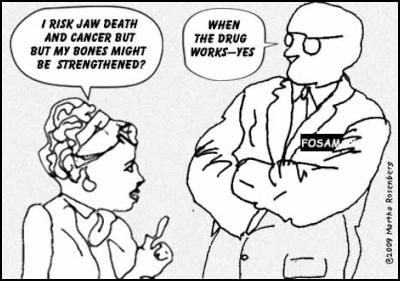Will Fosamax be Vioxx all over again?
Will Fosamax be Vioxx all over again?
By Martha Rosenberg
1999 was a good year for Merck.
In its 64 page annual report it predicted arthritis medicine Vioxx--Our Biggest, Fastest and Best Launch Ever!--would prevent Alzheimer's disease and colon cancer.
It announced it was seeking approval to market asthma drug Singular to two-year-olds.
And it predicted 40 million women would take its new osteoporosis drug the bisphosphonate Fosamax as it continued to "help educate both physicians and patients" about the bone disease.
Of course Vioxx was withdrawn in 2004 for doubling stroke and heart attacks in long term users, Singular is suspected of causing suicide and Fosamax is tightly linked to osteonecrosis, atrial fibrillation, intractable pain and now cancer.
While everyone knew Fosamax (alendronate) and the esophagus didn't mix--patients who don't remain upright for half an hour after taking it risk inflammation, ulcers, bleeding, blockage and sometimes perforation (see: landmine in throat)--no one expected the salvo from the FDA which appeared in the Jan. 1 New England Journal of Medicine.
"Crystalline material similar to ground alendronate tablets has been found in patients with erosive esophagitis, and persistent mucosal abnormalities have been noted in some of these patients, suggesting a potential for carcinogenic effects," wrote Diane Wysowski of the FDA's division of drug risk assessment.
In fact, there have been 23 reports of Fosamax-associated esophageal cancer in the US and eight deaths writes Wysowski. Europe and Japan have had 27 cases of esophageal cancer associated with Fosamax and similar drugs with six deaths.
And while most people knew Fosamax could cause osteonecrosis of the jaw (ONJ or jaw bone death)--dentists and the FDA reported it in 2004 though Merck wouldn't label it until 2005---few expected the definitive study in the Jan.1 Journal of the American Dental Association which said "even short-term oral use of alendronate led to ONJ."
Oops.
Like Vioxx which was launched a month early thanks to its collegial relationship with the FDA, Fosamax was rushed to market in 1995 six months after its application on the basis of two three-year studies.
Why hold up profits testing a drug when it can be "tested" on first users--the public--and make money at the same time? Merck may have paid $4.85 billion in 2007 to settle with 140,000 Vioxx heart attack victims--but it still made a profit. (see: forgiveness vs. permission).
So no one was surprised when Merck had to send a Dear Doctor letter about Fosamax--"Since market introduction some of these [esophageal] side effects have been of greater severity than we observed in our controlled clinical trials, said the letter,"--just months after approval.
In fact the FDA threatened to revoke its act-in-haste approval over the emerging side effects says Fortune magazine but the head of Merck research at the time, Edward M. Scolnick, "wrote to doctors, in his own hand, explaining the causes," and convinced the FDA "to let Merck keep Fosamax on the market, albeit with a warning label that told patients to sit upright for an hour after taking the drug."
Thanks to Merck's osteoporosis "awareness" campaign which included placing of its own bone density measuring machines in doctors offices in the 1990's, the number of people "at risk" for osteoporosis grew from half a million to 3.6 million.
But in addition to questions about osteonecrosis, esophagitis, an irregular heartbeat and other side effects--there were questions about Fosamax' very action as a "bone strengthening" drug.
Was Fosamax's anti-bone remodeling action that was supposed to stop or prevent osteoporosis actually making the bone more brittle and fracture prone because it was not "turned over"?
"We report atypical skeletal fragility in three subjects after long-term, combined anti-remodeling therapy," began a study in the Aug. 2008 Journal of Clinical Endocrinology & Metabolism.
"An Emerging Pattern Of Subtrochanteric Stress Fractures: A Long-Term Complication Of Alendronate Therapy?" was the title of another in the Feb. 2008 Injury.
"Low-Energy Femoral Shaft Fractures Associated
With Alendronate Use," was the title of another in the 2008
May-June Journal of Orthopedic Trauma.
Yes, Fosamax
emerged as a drug with dangerous side effects whose primary
action may not even work! And might even cause what it is
supposed to treat.
Or, as the old joke goes: bad food and such small portions.
There are even questions about the "large number of giant hypernucleated, detached osteoclasts" Fosamax creates--when its bone building "works"--also in the Jan.1 New England Journal of Medicine.
As with Vioxx, suspicious journal articles have surfaced that "sell" Fosamax like "Loss Of Treatment Benefit Due To Low Compliance With Bisphosphonate Therapy"--get it?--and "Consequences Of Poor Compliance With Bisphosphonates."
Posters like "Underuse of Osteoporosis Treatment in Postmenopausal Women," authored by an "employee of Merck & Co"--hello?--have been presented.
Merck-funded doctors have blamed ONJ on cancer and "bad oral hygiene."
But Merck's audacious Fosamax marketing--Merck will even threaten medical schools charges Tom Nesi in his 2008 book about Vioxx, Poison Pills--doesn't matter anymore.
Fosamax's patent ran out in February 2008 and Merck got its money's worth.
Martha Rosenberg is a columnist/cartoon who writes about public health.



 Gordon Campbell: On Why We Can’t Survive Two More Years Of This
Gordon Campbell: On Why We Can’t Survive Two More Years Of This Binoy Kampmark: Join The Army; Travel To Exotic, Distant Lands; And Radicalise
Binoy Kampmark: Join The Army; Travel To Exotic, Distant Lands; And Radicalise Ramzy Baroud: Letters from Gaza – ‘Alhamdulillah. We Are Not Okay’
Ramzy Baroud: Letters from Gaza – ‘Alhamdulillah. We Are Not Okay’ Ian Powell: Imperialism, Chagos Islanders And The Fight To Return
Ian Powell: Imperialism, Chagos Islanders And The Fight To Return Binoy Kampmark: Frail Egos And Sandpit Colonialism - Australia, The United States And Invading Iraq
Binoy Kampmark: Frail Egos And Sandpit Colonialism - Australia, The United States And Invading Iraq Binoy Kampmark: Ignoring A Leopard’s Spots - The UK, Syria And Courting Dictators
Binoy Kampmark: Ignoring A Leopard’s Spots - The UK, Syria And Courting Dictators